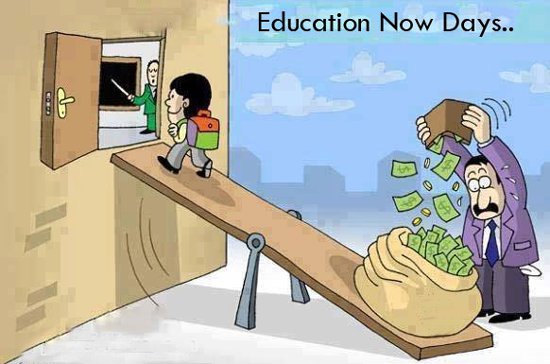“Education is what makes a person fearless, teaches him the lesson of unity, makes him aware of his rights and inspires him to struggle for his rights.”
– Dr B.R. Ambedkar
Irrefutably, the right to free and fair education is an inalienable birthright. Under the existing profound economic and social divide, the State’s roles are to cater for the aspiration and ideals of every child by embarking on a welfarist policy to make education affordable and accessible. The current scenario of the privatisation of educational institutions anyhow displays an ever-looming mirage of the State’s promises of free and fair education. This article briefly enunciates the unassailable right to education promised under the law and the existing conditions thereof.
The Constitutional Protection to Affordable Education
The marginalized communities were often tormented by upper caste and imperial veto in determining who ought to and who ought not to derive access to education, it was only in 1992, the Supreme Court in Mohini Jain V UOI jurisprudentially engraved the right to education into Part III (Fundamental rights) of the Indian Constitution. This case is monumental in its nature because, even in the absence of an express constitutional right with respect to education, the Supreme Court interpreted the right to education as a necessary condition for the fulfilment of the right to dignified life and liberty as promised under Article 21; to simply put forth it made right to life and right to education conterminously related with each other, i.e., if the excess capitation fee violated my right to education, it would impliedly and contemporaneously violate my right to life and human dignity. This dictum of the court further weighed into Part IV (Directive Principle of State Policy) of the Constitution and specified that while interpreting the right to education, it must be done so in alignment with the directive principles as outlined in Part IV of the Constitution. After a series of legal developments, the summation of the said constitutional rights are mentioned below:
(a) Every child or citizen in this nation possesses the right to receive a free education until the age of fourteen years. [In pursuant of J P Unnikrishnan vs. State of Andhra Pradesh, 2002, via the 86th- Constitutional Amendment. Article 21- A was inserted to provide free and compulsory education for all children between the age group of 6-14 years as a Fundamental Right.]
(b) Once a child or citizen surpasses the age of fourteen, their right to education is subject to the financial capacity and developmental constraints of the state. Despite the historical 86th amendment, hitherto, it is still noteworthy to assert that caste privilege and purchasing power play a predominant role in determining the affordability and access to quality education.
The Epoch of Privatization of Education in India
The neoliberal policies perceive privatization as a form of deregulated economic freedom, while it is nothing but an institutional process aimed at maximizing economic profit. In August 1995, a bill titled “A Private University Establishment and Regulation Bill” was introduced in the Rajya Sabha. This bill was introduced with the objective of establishing self-financing universities in the country. Consequently, as a result of this process, there has been a decrease in the public subsidies allocated to higher education. Later, the Higher Education Commission of India, as established under the UGC Act of 2018, introduced a bill formulated by the Ministry of Human Resource Development (MHRD) which reflected upon the government’s inclination towards the privatization of education.
Recently, the National Education Policy (NEP) of 2020 places significant trust in private institutions to act responsibly. Due to the restless privatization, the Indian higher education system has consistently encountered various challenges, including the imperative to ensure equity, quality, and access for all segments of society such as the following event.
Grave Impact of Liberal Privatization: The State’s Laissez- faire in Fee Regulation
In one such recent instance, on the 5th of January, 2023, The Hon’ble High Court of Karnataka pronounced in Rashmi Education Trust Vidyaniketan School & Others v. State of Karnataka & Others, declared Section 48 and other connected sections of the Karnataka Education Act 1983 (which prohibited private unaided schools from collecting a fee in any manner except as prescribed by the State government) as ultra vires to Article 14 of the Constitution. That is to say, the Hon’ble court granted the Private Educational Institution in Karnataka the liberty to determine their fee structure as opposed to complying with the State Government’s regulation.
The court while justifying the above matter has relied on a 11-judge bench decision i.e., T.M.A Pai Foundation V State of Karnataka. At para 44 of the order in Rashmi Education V State of Karnataka, the court has stated that the “fee structure must be left to the private institution the fee structure must, necessarily be left to the private unaided educational institutions, as those educational institutions do not seek or are not dependent upon any funds from the Government”(sic).
Whereas, one of the gravest ambiguities in T.M.A. Pai’s case is, it regardless utters that private institutions can determine their own fee structure but vehemently fails to explain the extent of the threshold of liberty to be granted to private educational institutions in determining the maximum cap. In the finding of the Rashmi Education Trust case too, the court has sufficiently left ample room for ambiguity plainly in the context of the lawful percentage of fee hikesinvariousprivateinstitutions.
Maliciously construing and pursuing the order, the private profit-driven educational institutions have exhibited their capitalistic greed and attack on constitutional values by immediately increasing the fee by 30-40%[1]. i.e, Rs. 50,000- 60,000 altogether. Leaving no room for any remedies, and the children’s right to continual education is halted while the parents suffer to fulfil the fee obligation.
Though the Hon’ble Court in Para 47 of the Rashmi Education Trust judgement has affixed a caveat stating “The cardinal rule would be to act just, fair and reasonable while formulating the fee structure, so that, no child would be deprived of elementary education in this welfare State, to fulfil the dreams of founding fathers of the Constitution of India”, ever since numerous complaints have been pouring in by the parents in accordance witnessing the non- compliance of the operative observation of the court. Given the above note, we the concerned students and citizens must vehemently condemn the extreme laissez-faire positioning of the State. We must demand the State’s intervention to end the unregulated fee structure.
Source:
[1]https://timesofindia.indiatimes.com/city/b engaluru/after-court-order-on-govt-role- private-schools-in-bengaluru-increase-fees- by-30-40/articleshow/99101023.cms? from=mdr



